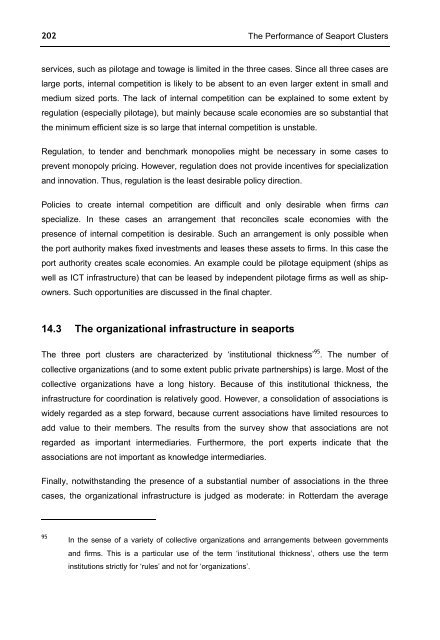The Performance of Seaport Clusters - RePub - Erasmus Universiteit ...
The Performance of Seaport Clusters - RePub - Erasmus Universiteit ...
The Performance of Seaport Clusters - RePub - Erasmus Universiteit ...
Create successful ePaper yourself
Turn your PDF publications into a flip-book with our unique Google optimized e-Paper software.
202<br />
<strong>The</strong> <strong>Performance</strong> <strong>of</strong> <strong>Seaport</strong> <strong>Clusters</strong><br />
services, such as pilotage and towage is limited in the three cases. Since all three cases are<br />
large ports, internal competition is likely to be absent to an even larger extent in small and<br />
medium sized ports. <strong>The</strong> lack <strong>of</strong> internal competition can be explained to some extent by<br />
regulation (especially pilotage), but mainly because scale economies are so substantial that<br />
the minimum efficient size is so large that internal competition is unstable.<br />
Regulation, to tender and benchmark monopolies might be necessary in some cases to<br />
prevent monopoly pricing. However, regulation does not provide incentives for specialization<br />
and innovation. Thus, regulation is the least desirable policy direction.<br />
Policies to create internal competition are difficult and only desirable when firms can<br />
specialize. In these cases an arrangement that reconciles scale economies with the<br />
presence <strong>of</strong> internal competition is desirable. Such an arrangement is only possible when<br />
the port authority makes fixed investments and leases these assets to firms. In this case the<br />
port authority creates scale economies. An example could be pilotage equipment (ships as<br />
well as ICT infrastructure) that can be leased by independent pilotage firms as well as ship-<br />
owners. Such opportunities are discussed in the final chapter.<br />
14.3 <strong>The</strong> organizational infrastructure in seaports<br />
<strong>The</strong> three port clusters are characterized by ‘institutional thickness’ 95 . <strong>The</strong> number <strong>of</strong><br />
collective organizations (and to some extent public private partnerships) is large. Most <strong>of</strong> the<br />
collective organizations have a long history. Because <strong>of</strong> this institutional thickness, the<br />
infrastructure for coordination is relatively good. However, a consolidation <strong>of</strong> associations is<br />
widely regarded as a step forward, because current associations have limited resources to<br />
add value to their members. <strong>The</strong> results from the survey show that associations are not<br />
regarded as important intermediaries. Furthermore, the port experts indicate that the<br />
associations are not important as knowledge intermediaries.<br />
Finally, notwithstanding the presence <strong>of</strong> a substantial number <strong>of</strong> associations in the three<br />
cases, the organizational infrastructure is judged as moderate: in Rotterdam the average<br />
95 In the sense <strong>of</strong> a variety <strong>of</strong> collective organizations and arrangements between governments<br />
and firms. This is a particular use <strong>of</strong> the term ‘institutional thickness’, others use the term<br />
institutions strictly for ‘rules’ and not for ‘organizations’.

















